5 High-Impact Approaches to Influencer Marketing for Ecommerce Brands
For Ecommerce companies, building a homegrown fan base is hard. This is especially true if you discount all the family and friends you coerced into hitting ‘like’ on your Facebook page.
But I’ll let you in on a secret: You don’t have to do it alone.
Across the web, tens of thousands of ‘ordinary people’ work long, grueling 10-hour days crafting and promoting their personal brands online. These new media celebrities call WordPress, Instagram and Facebook home. And with each blog post, photo or status update they publish, they garner the attention of thousands, if not millions, of fans who absolutely adore them.
They’ve done all the hard work of creating an active and engaged audience. And clever marketers can use that to their advantage. Below, we’ve listed five ways Ecommerce brands can partner with influencers to promote their business and products, followed by tips for making the most of your next influencer marketing campaign.
You can find 3 tried and true ways to grow your store here:
1. Blogs: Sponsored product reviews
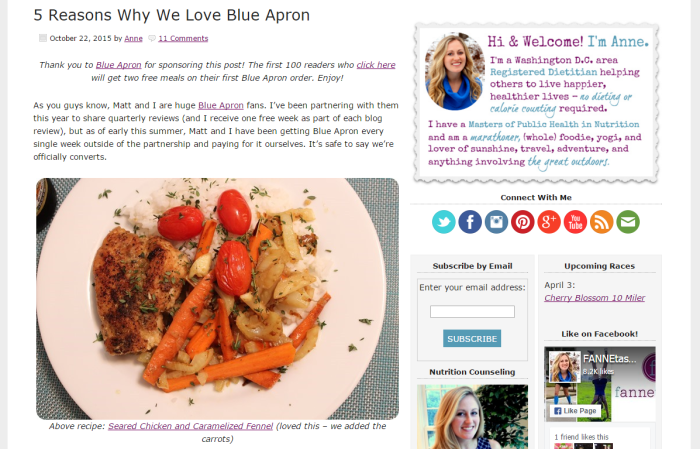
In 2015, fresh meals delivery service Blue Apron partnered with Anne Mauney, a registered dietician and author of the fANNEtastic food blog, to sponsor quarterly reviews of its product. This series of blog posts gave Blue Apron frequent access to fANNEtastic food’s massive, health-conscious audience (according to Mauney, her blog receives upwards to 450,000 pageviews a month). With this format, Blue Apron received written endorsement of its product including reasons why Mauney loved its service, and her readers responded positively.
Essentially, Blue Apron strategically tapped an influential blogger who already had a strong relationship with consumers who trusted her, and leveraged that to drive brand awareness and product sales. But this wasn’t a standalone campaign. The company regularly works with lifestyle bloggers to promote its service. In 2014, Mommy blogger Katie Bower of Bower Power wrote about her awesome experience using Blue Apron to feed her family. That same year, Janae of The Hungry Runner Girl recommended the service too. Across the web, you will find dozens of other sponsored and organic posts about Blue Apron’s fresh meals delivery service. As a business that was last reported to be worth $2 billion, it is doing something right.
2. Instagram: Targeted product placement
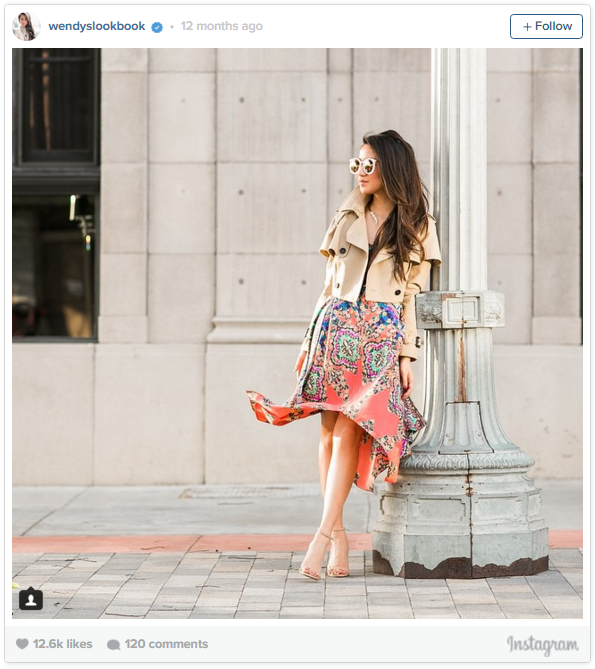
When Lord & Taylor launched its Design Lab collection, it decided to spotlight one particular dress which it promoted heavily on Instagram. David Griner of Adweek reports, “Lord & Taylor got 50 Instagrammers to wear the same dress, which promptly sold out.” For its campaign, Lord & Taylor identified 50 fashionistas, each with thousands of engaged followers on Instagram, to post pictures of themselves wearing the dress over a weekend. Griner writes, “Many of the posts generated more than 1,000 Likes each, with several surpassing 5,000 Likes and some reaching rarified levels like 13,000 Likes.”
The campaign helped customers get a better idea of how the dress might look when worn different ways and in different environments, on women with different styles. And it was a huge success also because the popular Instagrammers sporting the dress used the hashtag #OOTD (Outfit Of The Day), flooding Instagram feeds everywhere.
3. Pinterest: Co-created collections
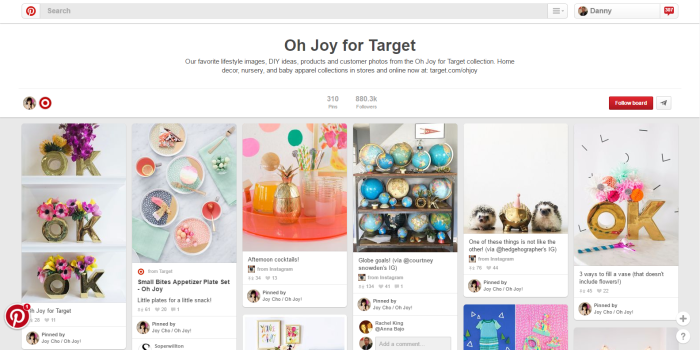
With 12.8 million followers, Joy Cho of Oh Joy! is a bit of a Pinterest celebrity. So, it made sense when Target reached out to her to develop her own home decor, nursery and baby apparel collections to be sold in Target’s retail stores and online. As part of the collaboration, Cho also curated the Oh Joy for Target board, which exclusively features products she designed. To date, the board has amassed a whopping 880,300 followers.
For the same campaign, Target teamed up with influential pinners Poppytalk and Wit & Delight to produce co-branded party supply collections too. On Pinterest, the Poppytalk for Target board currently has 611,600 followers while the Wit & Delight for Target board has 1.1 million followers.
4. Vine: Product advertisements
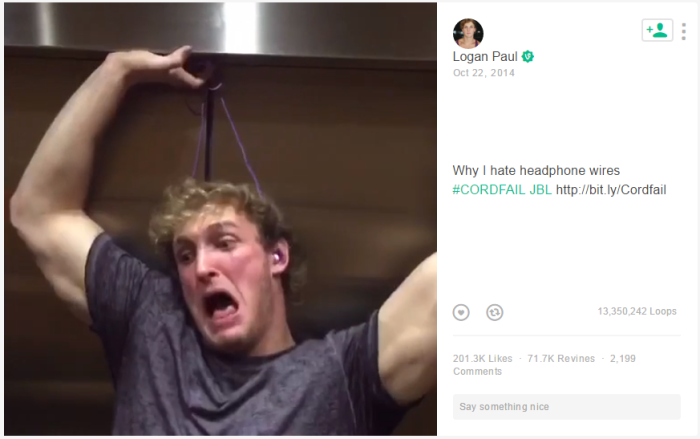
As far as I can remember, advertisements were those annoying 30-second clips that interrupted my favorite TV shows; 30 seconds, no more and no less. To their credit though, it was impressive that anyone could pack so much information into such little time. Yet, brands on Vine have managed to do the impossible: Tell their story and demonstrate product benefits in under six seconds. One example of this is JBL’s The Cordfail Effect campaign.
To promote its cordless headphones, JBL enlisted top Vine users to demonstrate the downsides of wearing corded headphones. Following the launch of the campaign, Digiday reporter Tanya Dua wrote, “We’ve all had annoying, frustrating and downright comical stories involving entangled headphone wires. And now, JBL wants to bring them to life. The audio electronics company has launched #cordfail, a campaign promoting its Bluetooth-enabled wireless Synchros headphones, that humorously highlights the pitfalls of traditional corded headphones.”
At the time, JBL partnered with Vine power users Arantza, Jerry Purpdrank and Logan Paul to demonstrate everyday frustrations that corded headphone users faced being tethered to their music players — and the Vines went viral. A recent Vine from Arantza has 3.8 million loops. One posted by Jerry Purpdrank on the same day has 7.7 million loops. And one dating back to the start of the campaign by Logan Paul has 13.3 million loops.
5. YouTube: Quirky giveaways
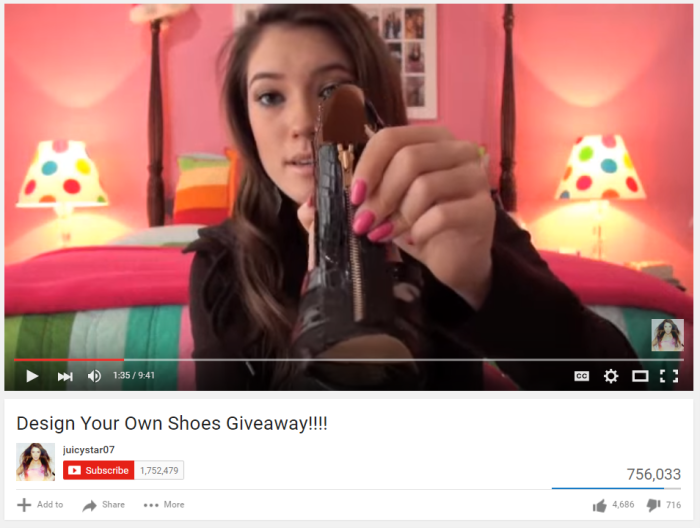
Back in 2010, when brands were still trying to make sense of Facebook and Twitter, custom women’s shoe company Shoes of Prey took a risk and decided to team up with 16-year old beauty vlogger Blair Fowler to host a giveaway on her YouTube channel. Known as JuicyStar07, Fowler produced a 9 minute and 41 second long video titled, “Design Your Own Shoes Giveaway!!!!,” in which she showed viewers a custom shoe she designed herself using the Shoes of Prey website along with a quick tutorial for how others could do the same.
In a week, the video had generated nearly half a million views. Within two months, it also earned media coverage in The Wall Street Journal, Business Insider and Media Gazer, and helped the business permanently triple its sales. By harnessing the power of an influential vlogger, Shoes of Prey reached a massive, new audience and drove significant revenue.
Maximizing the ROI of your next campaign
Before you initiate your next influencer marketing campaign, Mediakix recommends following five steps:
- “Know your target audience.” To identify which platforms to pursue.
- “Research the influencers you’ll work with.” To find influencers who share the same interests and values.
- “Look at content and engagement.” To learn more about the topics they cover and to gauge how active their audience is.
- “Review branded content examples.” To evaluate how they promote their sponsors and see if there has been any audience backlash.
- “Create a lasting relationship.” So that the influencers you recruit develop a deeper appreciation for your brand, allowing them to produce higher quality sponsored content in the future.
Of course, there are other details we must not overlook. For example, most influencers will expect some form of compensation. Three ways you can structure a deal are by:
- Providing free product to your influencer in exchange for a published product review
- Offering a cash payment for their endorsement
- Creating a performance-based program using affiliate links
To sweeten the pot for your influencer’s audience, offer their fans, followers, readers, or viewers an exclusive, limited-time discount or a product giveaway.
Additionally, you may want to consider partnering with up-and-coming influencers; every social media star has to start somewhere, and it would behoove you to ‘find’ them first before they begin charging astronomical rates for product endorsement. Within a couple of years, we are guaranteed to have a new generation of social media celebrities who may end up being more popular than the social media personalities we all keep up with now.
And as with any marketing campaign, you should take an integrated approach. If, for instance, your influencer promotes your brand on their blog, share their endorsement across your company’s social media accounts. Consider publishing it on your website too to demonstrate social proof and use it the same way you might use a customer testimonial. If the campaign drives traffic that converts well, amplify its reach with additional paid media. Or, follow Shoes of Prey’s lead by using your influencer partnership as collateral for your public relations efforts to generate media coverage.
Finally, remember to comply with FTC regulations on endorsements by providing sponsorship disclosures with each paid influencer marketing campaign. Lord & Taylor was eventually sued for its wildly successful Instagram campaign because, at the time of publishing, none of its paid influencers disclosed their financial arrangement with the brand.